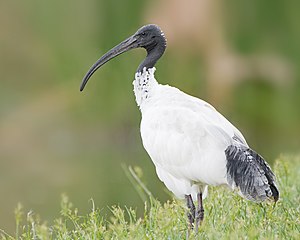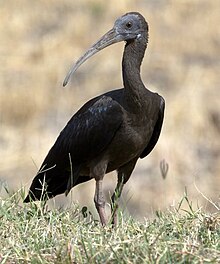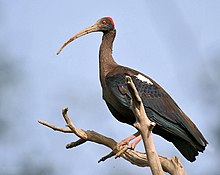Ibises
| Ibises | ||||||||||||||
|---|---|---|---|---|---|---|---|---|---|---|---|---|---|---|
|
Obsolete systematic group The taxon dealt with here is not part of the systematics presented in the German-language Wikipedia. More information can be found in the article text. |
||||||||||||||

Moluccan ibis ( Threskiornis molucca ) |
||||||||||||||
| Systematics | ||||||||||||||
|
||||||||||||||
| Scientific name | ||||||||||||||
| Threskiornithinae | ||||||||||||||
| Poche , 1904 | ||||||||||||||
The Ibisse or Sichler (Threskiornithinae) are a sub-family of ibis and Löffler in the order Pelecaniformes . These are mostly water-based birds with long, curved beaks.
features
Ibises have a length of 50 to 110 cm. It is characterized by the long, slender and curved beak. This is often used to poke for food in muddy ground; in the case of the inhabitants of rather dry habitats, it is also introduced into crevices in the rock. The wide wings allow a quick, powerful flight.
distribution and habitat
Ibises inhabit the tropical, subtropical and moderately warm zones worldwide. The typical habitat are the banks of lakes or slowly flowing rivers, both in open landscapes and in dense rainforests. However, some species also live in steppes and savannas. The still existing populations of the wood ibex even live in rocky semi-deserts, where water binding is least pronounced.
nutrition
Many species eat aquatic insects, insect larvae, small crustaceans and molluscs, and more rarely also small fish and amphibians. The few species that live away from the water in drier areas, on the other hand, feed on grasshoppers, beetles, spiders and snails, and more rarely on lizards, snakes and mice. All ibises use their long beak to search for something edible by introducing it into mud and soil.
Reproduction
Because of the great correspondence with the reproduction of the spoonbills, this topic is dealt with together with ibises and spoonbills .
Ibises and people
Interrelationships
The ancient Egyptians , who depicted the god Thoth with the head of an ibis, had a close relationship with the ibis . The fact that ibises appeared every year during the floods of the Nile in Egypt may have been the reason for their worship. Images of ibis can be found on wall paintings, mummified ibises were discovered in graves. Mummification was very complex and even went so far that the embalmed stomach of the animal was filled with bird seed. The mummified birds were offered as votive gifts and placed in rock catacombs. Archaeologists have discovered around 1.75 million such ibis corpses in a cult site in Saqqara . A misunderstanding, however, is the name Holy Ibis , which is modern. The assumption that it is the bird worshiped by the ancient Egyptians cannot be proven. In fact, the sacred Ibis should the Egyptians the bald ibis have been, who lived in ancient times still in Egypt and was only later supplanted by the Holy Ibis.
As we know from Conrad Gessner's Historia Animalium , the bald ibis was also widespread in the mountains of Europe, for example in the Alps , until the 16th century . The extinction of the only Central European ibis probably had several causes. Hunting, landscape destruction and the cooling of the climate are believed to be the most essential.
Ibises, and also in this case bald ibises, also appear in connection with the biblical story of Noah's Ark , even if only in a detail that is locally widespread in eastern Anatolia. Here it was an ibis that led Noah after the end of the flood from Mount Ararat down into the valley to the upper Euphrates , where Noah and his family settled down. For this reason the ibis was worshiped with annual festivals in the Birecik area .
Threat and protection
The bald ibis, a species that used to be widespread in the Mediterranean and Central Europe, is now threatened with extinction. In addition to the tiny colony of Birecik and a few other birds in Syria , this ibis still lives mainly in Morocco . There its number has increased again due to intensive protective measures, but it is still listed by the IUCN as critically endangered - a dramatic development in view of the former ubiquity of this bird.
Other ibises listed as Endangered by the IUCN include:
Endangered: black nape
Highly endangered: Madagascan holy ibis , nipponibis (extinct in Japan since 2003, last colony in Shaanxi has been multiplying for several years thanks to strict protective measures, which is why the bird has no longer been considered endangered since 2000).
Threatened with extinction: White-shouldered ibis (only in southern Vietnam, Cambodia and central Borneo, once spread over Southeast Asia), giant ibis (only in southern Laos and Vietnam and northern Cambodia).
Extinct is the Réunionibis . Only bone finds are known of this animal. However, it is assumed that this is the previously enigmatic Réunion solitaire or white dodo, which appears in old reports and which was hastily classified as a relative of the dodo . If this assumption is correct, then the Réunion ibis became extinct at the beginning of the 18th century.
species
-
Threskiornis
- Black- headed ibis ( T. melanocephalus )
- Moluccan ibis ( T. molucca )
- Spiny ibis ( T. spinicollis )
- Sacred ibis ( T. aethiopicus )
- Light-eyed ibis ( T. bernieri )
- † Réunionibis ( T. solitarius )
-
Pseudibis
- Warty ibis ( P. papillosa )
- White-shouldered ibis ( P. davisoni )
- Giant ibis ( P. gigantea )
-
Geronticus
- Waldrapp ( G. eremita )
- Smooth-necked black horse ( G. calvus )
-
Nipponia
- Nipponibis ( N. nippon )
-
Bostrychia
- Hagedasch ( B. hagedash )
- Klunkeribis ( B. carunculata )
- Spotted ibis ( B. rara )
- Guineaibis ( B. olivacea )
- Dwarf olive ibis ( B. bocagei )
-
Theristicus
- Headbandibis ( T. caerulescens )
- White-necked ibis ( T. caudatus )
- Andenibis ( T. branickii )
- Black-rein ibis ( T. melanopis )
-
Cercibis
- Long-tailed ibis ( C. oxycerca )
-
Mesembrinibis
- Green ibis or cayenne ibis ( M. cayennensis )
-
Phimosus
- Black ibis ( P. infuscatus )
-
Eudocimus
- Snow ibis ( E. albus )
- Scarlet ibis ( E. ruber )
-
Plegadis
- Brown ibis ( P. falcinellus )
- White-faced ibis ( P. chihi )
- Narrow-billed ibis ( P. ridgwayi )
-
Lophotibis
- Crested ibis ( L. cristata )
- † Apteribis
Originally the ibises (Threskiornithinae) were one of two subfamilies in the family of ibises and spoonbills (Threskiornithidae). However, it turned out to be paraphyletic without the involvement of the spoonbills , so that the use of the two subfamilies had to be abandoned. Instead, one can distinguish two clades within the ibis and spoonbills family, one that only occurs in the New World and consists of the genera Eudocimus , Phimosus , Theristicus, and one that is distributed almost worldwide with the other genera including the spoonbill. Both lines of evolution separated from one another 39 to 42 million years ago.
Individual evidence
- ↑ del Hoyo et al .: HBW Volume 1, Morphological Aspects , pp. 473-475, see literature
- ↑ del Hoyo et al .: HBW Volume 1, Habitat , pp. 475-476, see literature
- ↑ del Hoyo et al .: HBW Volume 1, Food and Feeding , pp. 477-480, see literature
- ↑ Karin Schlott: Egyptians filled ibismummies with bird food. In: epoc. January 27, 2012, accessed January 28, 2012 .
- ↑ a b c del Hoyo et al .: HBW Volume 1, Relationship with Man , pp. 484-485, see literature
- ↑ Threskiornis solitarius in the endangered Red List species the IUCN 2011. Posted by: BirdLife International, 2008. Accessed November 13, 2011th
- ^ R. Terry Chesser, Carol KL Yeung, Cheng-Te Yao, Xiu-Hua Tian, and Shou-Hsien Li: Molecular phylogeny of the spoonbills (Aves: Threskiornithidae) based on mitochondrial DNA . Zootaxa, V. 2603, 2010
- ↑ a b J.L. Ramirez, CY Miyaki and SN Del Lama: phylogeny of Threskiornithidae (Aves: Pelecaniformes) based on nuclear and mitochondrial DNA Genetics and molecular research: GMR 12 (3): 2740 July 2013, DOI: 10.4238 / 2013.July.30.11
literature
- Josep del Hoyo et al .: Handbook of the Birds of the World. Volume 1: Ostrich to Ducks. Lynx Edicions, 1992, ISBN 84-87334-10-5 .







